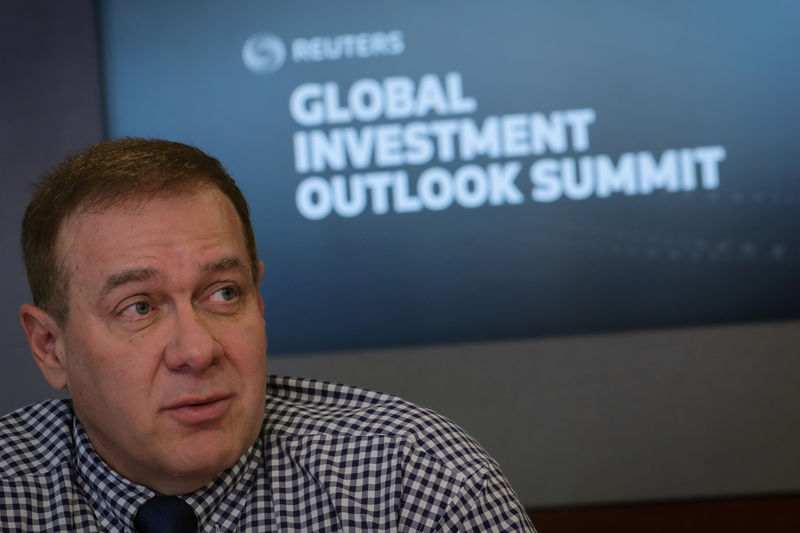 © Reuters. Scott Minerd, Chairman of Guggenheim Investments and Global Chief Investment Officer, speaks during the Reuters Global Investment 2019 Outlook Summit, in New York
© Reuters. Scott Minerd, Chairman of Guggenheim Investments and Global Chief Investment Officer, speaks during the Reuters Global Investment 2019 Outlook Summit, in New YorkBy Jennifer Ablan
NEW YORK (Reuters) – The Federal Reserve is likely to hold its interest rate hikes on pause for the start of 2019 in order to stabilize markets, given economic growth is set to slow and financial conditions having tightened, Guggenheim Partners Global Chief Investment Officer Scott Minerd said on Wednesday.
In Guggenheim’s annual letter on macro themes, Minerd, who oversees $265 billion in assets, said the stock market selloff represents “a negative wealth shock to consumers, who have been the engine of growth for the U.S. economy in this expansion. At the same time, tighter credit conditions will also weigh on business investment and hiring activity in 2019.”
Last week, Federal Reserve chairman Jerome Powell reiterated that the Fed plans to evaluate the health of the economy before moving ahead with any new interest rate increases.
Minerd said, “With a Fed pause helping to abate monetary policy concerns, the market will likely turn its focus to fundamental data. A relative bright spot following 2018’s volatile end will be earnings growth, which is projected by analysts to be 9 percent for 2019.”
Minerd said while this would represent a slowdown from the 27 percent rise in earnings in 2018, it would still be above the historical average. “The combination of decent earnings growth and a modest recovery in price/earnings multiples will likely push the to new highs.”
A pause in monetary policy tightening may grant “a short-lived reprieve” to debtors facing pressure from rising borrowing costs, he said.
“This will encourage more debt accumulation in the first half 2019 as borrowers take advantage of calmer market conditions, particularly in investment-grade corporates,” Minerd said.
Minerd said while the Fed will slow the pace of rate hikes, it would not stop hiking altogether given how strong the labor market continues to be.
“Job openings now exceed the number of unemployed, causing many businesses to complain of shortages of qualified workers, raising labor’s bargaining power, and driving up wage growth.”
Minerd said Guggenheim expects the Fed will raise rates two times in 2019 “to try to cool the labor market to a more sustainable pace.
“Our forecast of two Fed rate hikes in 2019 would bring the January 2020 fed funds futures-implied rate to around 2.90 percent, lifting the to about 3.15 percent,” he said. “We see a broad-based slowdown in real GDP growth to below 2 percent year-over-year by the fourth quarter of 2019.”
While GDP growth is set to decelerate meaningfully in 2019, the economy is unlikely to enter a recession this year, Minerd said.
“Our recession model is signaling relatively low recession risk in the next 12 months. The yield curve has not yet inverted, Fed policy is not yet restrictive, and leading indicators, though slowing, are still positive.”
Minerd said Guggenheim continues to expect a recession will begin in 2020.
“We continue to expect a recession will begin in 2020, as a historically tight labor market forces further tightening by the Fed, pushing the overleveraged corporate sector into a downturn,” he said.
“With the 2020 election looming and voters appearing to prefer confrontation over compromise, bi-partisan efforts will be increasingly difficult, resulting in gridlock.”
Partisan conflicts will become more acute with Democrats having recently taken control of the House of Representatives, as they now have subpoena power, Minerd notes.
“Legislative battles over the budget, trade issues, the debt ceiling, and investigations into the Trump administration will undermine confidence and weigh on markets,” he said.
Source: Investing.com





























